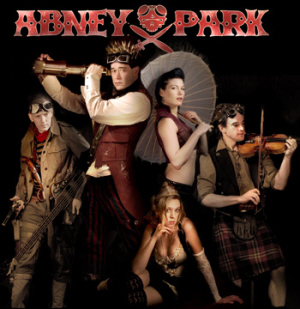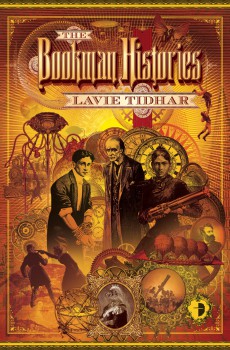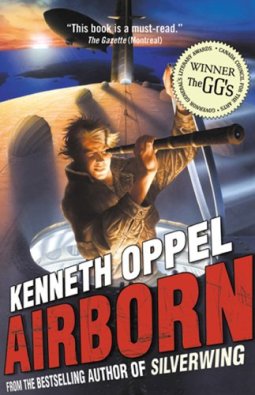What’s the Point of Steampunk?
 Over on Farcebook, I once posted an admiring link to Abney Park and got an irritated slapdown from a mate who is slightly more politically correct than I.
Over on Farcebook, I once posted an admiring link to Abney Park and got an irritated slapdown from a mate who is slightly more politically correct than I.
(Abney Park, if you’ve just tuned in, are like Maximus from Gladiator: The Steampunk band that made an album that became a roleplaying game that became a novel. With songs like “Airship Pirate” and “Steampunk Revolution,” they push all the tropish buttons, but they are more than just a concept band; they can sing and play. I think of their style as Electric Urban Folk; they’ve taken all the sounds you’d hear in pre-WWII cosmopolitan cities — Jazz, ballad, sea shanties, gypsy fiddle, marching songs — then rocked them up using a mixture of traditional and electric instruments.)
My friend, however, dismissed them and Steampunk as something like; “socially retrodyne misogynist crypto-imperialist nostalgia”.
I am afraid that my off-the-cuff response was, “WHAT WAS THAT, SIR? I CAN’T HEAR YOU OVER THE SOUND OF MY ZEPPELIN ENGINES.”
Afterwards, I wish I had mounted a more serious defense of the genre.
I guess this is it.
Let’s deal with the fashion and music first.
Oddly, Steampunk is most visible as a fashion subculture. As somebody once said, it is what happens when Goths discover brown.

Something quite so playful hardly needs defending. However, if I must:
Sure, corsets and gentleman’s formal suits are probably only fun when social mores don’t force you into them and the Victorian period is one of misogyny, racism, and imperialism. However, this is pretty much true of every period, other than our own, and we ourselves are only exempt from the accusation if we are careful what company we keep.
Presumably Lindy Hoppers should put away their petticoats and wingtips; shame on you for embracing an era when the Klan ran rampant and patriarchy was the norm! The Society for Creative Anachronism should also put down their swords and start closing down all those Renaissance Fairs. While we’re at it, let’s have no more toga parties…
It follows that unless you are prepared to repudiate all Historical fashions and fads (except those relating to whichever political movement you embrace), then you have no business painting Steampunk fashion as morally or politically dubious.
The same goes for Steampunk music; it’s fun and if it has one foot in the unpleasant past, then so does a lot of Classical music: Stravinsky’s Rites of Spring glorifies pagan times when it was apparently routine for a young woman to dance herself to death as a human sacrifice and Wagner’s Die Meistersinger von Nürnberg revels in a patriarchal Medieval past when a young woman could be the prize in a singing contest. And so on.
Now — at last — to literature. Steampunk Fiction. What’s it good for?

Above all, “sense of wonder.” Corset-clad beauties peering through goggles from the cockpits of Zeppelins while gatling bullets ping sparks of off riveted machines of brass and iron… it’s all just cool. If you don’t like this kind of cool, fine, step off the zeppelin and make room for somebody else.
However, Steampunk settings are about more than just window dressing. The genre seems to serve three literary purposes.
First, Steampunk can be a way of exploring historical forces.
Typically it lets writers hammer out magical realist riffs on the 19th century, using exaggeration to bring to the surface technological, social, and intellectual undercurrents. In a sense, such books are an archaeology of lost aspirations, but they also rub our noses in the downside of the milieu: the grime, the exploitation, the casual racism, and the imperialism.
The classic example of this is Gibson and Sterling’s Difference Engine, but you also see this in more recent works, such as Tidhar’s Bookman Chronicles. In both, Babbage is in the ascendant, the Industrial Revolution in full swing, Imperialism the norm, and poverty the underbelly.
Next, Quasi-Victorian Steampunk presents a world like ours, but less reformed, and simpler. This makes it easier to dissect aspects of modernity. For example, it’s possible to look at the impact of technology without getting bogged down in legislation and public enquiries. Similarly, if you are interested in glass ceilings and Feminism, then you can pen a tale in which a liberated woman battles the forces of sexism to get to her objectives without any sense that she is an anachronism. A good example of this is Priest’s Boneshaker.
Finally, Steampunk, since it presents a dream version of our own world, is a substitute for classic Science Fiction.
The point of yesteryear’s Science Fiction was rarely to predict the future. Rather it used science to carry out thought experiments and to send fairly modern-seeming people on adventures.
Most “thought experiment” SF — of the kind penned by Asimov and Arthur C Clark — wouldn’t even survive the Present! We are now painfully aware of risk assessments, health and safety, bureaucracy, human rights, and professionalism. Nobody is going to get to take home an experimental sentient android. Nor is anybody other than a highly trained and screened specialist ever going to make first contact with aliens. We do get new war machines, but they take years to develop, involve countless committees, and though not infallible, are rigorously tested before getting anywhere near a battlefield.

Thought experiments are alive and well in Steampunk, however. Take the Corsets and Clockwork collection of Steampunk romances. It even has an android story!
Adventure SF would also have a problem in the Present; DNA testing, face recognition, crime databases, mobile phones, and security systems take the venture out of adventure.
The Future is worse.
Vertical farms will feed the world, asteroid mining and 3D printing will provide its goods, so no need for tramp merchants or bulk carriers, no opportunity for space pirates and not much point in empires. Nanotechnology and ubiquitous surveillance will keep us healthy, safe, and law-abiding.
Flinx won’t get through customs, and, armed with GPS and good communications, Stark will never need to go native. And you can forget laser shoot-outs or Vietnam-in-space. War will be done with mini-drones and autonomous agents.
Steampunk gets around all this by simply sticking to souped-up versions of 19th century technology, where anything world-breaking is bespoke and probably unreliable, and adhering to the 19th century milieu of lone inventors and gentlemen amateurs.
Thus we get romps like Ballantine and Morris’s Ministry of Peculiar Occurrences, which would once have been some kind of Space Patrol series, Oppel’s Airborn books which could have been Andre Norton space cadet adventures, and Reeve’s Predator City series, which would make a nice EE “Doc” Smith series…
…which I suppose explains my original response; Steampunk lets us have fun and enjoy the stories we want.
Now where did I put my goggles?
M Harold Page (www.mharoldpage.com) is a Scottish-based writer and swordsman who knows more than he should about Zeppelins. His historical adventure yarns are all available on Amazon. The next one has Vikings in it.
>>“socially retrodyne misogynist crypto-imperialist nostalgia”<<
That is what I like about Steampunk…
I know someone who dismissed Abney Park’s music without listening due to the way they were dressed. I guess with a stage act like that, the music couldn’t be any good. But that does leave me wondering how much attention your friend paid to their lyrics before rendering judgment.
The lineup for the Lost Horizons album is my preferred one.
I missed out on Heavy Metal for years for similar reasons! It happens 🙁
Some of the Abney Park lyrics are profound, in a kind of minimalist way. The Story that Never Starts being a good example (https://www.youtube.com/watch?v=PpGF9bDTLoI&feature=kp)
As, I think, the friend in question:
I Find AP’s music to be dull.
Which is a shame because I really like what they’re trying. I like folk, I like contemporary folk, I like genre mashing music of this sort. My biggest music fandom is Paul Simon because his career is an ever expanding repertoire of different, and varied musical styles and genres skilfully and respectfully woven together.
And as my wife was a fan, yes, I heard my share of Abney Park and it’s simply of poor quality, and the poor quality shows because the style appropriates a veneer of complexity.
As for the wider point – I disagree wholeheartedly that the Victorian era was no more misogynistic, oppressive, and imperialist than any other. Victorian sensibility made a positive virtue of oppression, suppression, exploitation and the maintenance of privilege and power – and it’s fashions were very much a part of that.
Classical society had it’s problems but there was at-least some kind of enlightened ideal. Feudal society had it’s problems but the feudal arrangement was at-least supposed to work both ways.
Victorian sensibility engrained into moral value the rights and privileges of the oppressor, and more than that – the righteousness of oppression.
The era of the gentleman traveller, the amateur scientist, the adventurer was paid for by the era of mills, the poor house, bridges and railways paid for in labourers’ blood. And that was just at home.
But that’s cool. Airships are cool, amateur science is cool. Top-hats and corsets are cool. Good thing that, in Steam Punk, dressing as the chimney sweep is just another aesthetic choice.
@sryalls: Nicely put. I shall sit back and see if anybody else has an interesting response.
“It is what happens when Goths discover brown.”
That cracked me up! (Incidentally, would “goths” probably not be capitalized here, since “Goths” technically would be referring to the medieval tribe rather than the subculture?)
This post strikes me as a pretty erudite — and entertaining! — summary of steampunk’s defining traits and it’s appeal — “what it’s good for.”
Another thing occurred to me after Page got me thinking on it. This observation comes from considering steampunk from the fantasy angle, and, I don’t know, it may supplement the retro-scifi angle that was well covered:
Most fairy-tale and fantasy settings, going all the way back to Romantic and Victorian-era literature, have been predominated by a pastoral, pseudo-medieval setting. Fantasy in the twentieth century, especially in the S&S branch, often delved back even further — to the Dark Ages and earlier. But as we approached the twenty-first century and the rise of steampunk, could another influencing factor be that “fantasists”were ranging ahead and mining imaginative versions of the Victorian era because — for one thing — that era now seems as distant and fairy-taleseque to us from our vantage as medieval times were to Victorian writers?
And the fact that there is a strong retro-scifi element also makes sense in this context — in addition to providing all the storytelling benefits you enumerated above, it harkens back to early industrial technology that seems increasingly strange and foreign to us. If you’ve ever walked through a moth-balled factory in the shadow of bizarre looming machines, or seen one up close in a museum — mechanical monstrosities with Rube-Goldbergian mazes of pipes and belts, cogs and wheels, funnels and bellows, spigots and levers and cranks and other mysterious parts of unknown function — you know how strange and otherworldly they can seem. Their very alienness can easily be conflated with a kind of magic or primitive enchantment (a proviso perhaps to Arthur C. Clarke’s famous maxim — that any technology sufficiently advanced is indistinguishable from magic — could be that any technology sufficiently old and primitive can also seem magical). Sure, our smartphones and iPads and Roombas are all descended from these machines just a few generations removed — but it’s as if you looked back at your genealogical record and discovered that your great-great grandfather was a Gigantopithecus or a dinosaur!
And so this increasingly distant and unfamiliar technology becomes part of the landscape — motifs of this era as re-imagined through a fantasy lens. But since such technology is based on or inspired by technology that did exist — in the same sense that antecedents for the armored knights of King Arthur’s court did exist, however glorified and elevated above their sources the legends may have been — science fiction effectively becomes an element of the fantasy.
Well, that’s as far along that path as I’m going to ponder — I meant to write a comment, not the beginnings of an academic paper! Again, thanks for a great post that got my cogs and wheels turning. (I may even have to don my goggles.)
@sandy: While we’re waiting please consider that most periods of history are bloody awful if you look too close! Most civilised achievements were built on imperialism and appalling exploitation of slaves and workers, and those societies that weren’t into Wonder Building were too busy head hunting, raiding and slaving.
(http://www.blackgate.com/2013/11/28/heroic-historical-and-uncomfortable-truths/)
@Nick Ozment: Yes. I was groping to articulate this. I think there’s something else as well: Fantasy plays with (mostly) Medieval(ish) archetypes. Steampunk plays with modern archetypes.
Is there anything from which the nattering nabobs of negativity won’t attempt to suck the fun?
@Ken: No.
Except for nattering itself, which, presumably, they must be deriving some warped sort of self-righteous fun from.
Folks! I was expecting something a little more reasoned than “Get orf my Zeppelin! Can’t you see I just polished the rivets!”
Zepplins shouldnt be steampunk…
They are more dieselpunk.
Oh no! A Steampunk fundamentalist!
I think Zeppelins are OK because 1. They are cool, and 2. They are a Victorian technology pushed beyond its limits.
@sryalls:
Since nobody else has picked up your points:
I hope you’ll agree that Steampunk as a literary genre has to be taken on a case by case basis; often Steampunk settings are dystopias, not glorifying those things that are obnoxious to you.
It is Steampunk fashion, music, and light adventure literature which we are really debating over.
My argument is that all history is pretty awful and that it’s either OK to play with the fun bits or it is not.
You say the Victorian era was particularly obnoxious and should be beyond the pale for such frolics.
> Classical society had it’s problems but there was at-least some kind of enlightened ideal. Feudal society had it’s problems but the feudal arrangement was at-least supposed to work both ways.
> Victorian sensibility engrained into moral value the rights and privileges of the oppressor, and more than that – the righteousness of oppression.
However, Feudal society had its philosophical underpinnings, thought heretic burning was OK and enjoyed crusades as a pastime. Many of those enlightened Greek philosophers developed whole intellectual systems to justify slavery. Plus misogyny…
The Victorian period, in contrast, is when people questioned slavery, oppression, and imperialism pretty much for the first time ever!
The literature, of-course, has to be taken case by case.
On a wide scale, you might have a point but my observation of people playing with steam punk is a fixation on the gentry of the time.
I made a gag about dressing as the chimney sweep but lets face it, that’s not what steam-punk as an aesthetic is about. It’s about emulating the most entrenched and obnoxious privilege seen before modern times while utterly hand-waving the cost of it.
I’m not seriously going to object to someone putting on an old military jacket or waistcoat for a night out. We all accessorise, and sometimes it is just about looking good.
…but the guys who *really* do the steam-punk thing – it’s often about affecting an air of privileged douche-bag that is somehow magically made classy by it’s nod to history.
My objection is about what the aesthetic says about the wearer than the period of history specifically.
You put on a toga and you are making a not towards learning. As much as we ever let medieval fashion creep into modern dress – it’s normally used as a not to chivalry, or bravery, or honour.
Victoriana – Nah. It’s about affecting an air of privileged superiority, mistaking it for class, and more-often-than-not completely keeping out of mind the cost that that affectation came at.
I saw that interview from the guy from AP that was posted previously. I’ve listened to him talk before – listen to his language. Steam Punk isn’t just about fun. It’s about superiority. The way the guy talks about the people who do and do not appreciate the aesthetic – it’s a door to some secret snobbery. Which would be fine, rock-star douche-bag can say what he likes except we know exactly *why* victoriana is the key to snobbery – because snobbery characterises the Victorian age. Mindless, reasonless snobbery. And it’s *this* concept that steam-punks are often trying to tap into.
All ages were full of mindless snobbery. The Middle Ages, for example, had laws dictating how people could dress according to class, minutely calculated degrees of nobility and so on.
We once met a reenactment group that took squiredom so seriously that the squires were fetching and carrying and mylording even when the public had gone!
When people play with the past, they are usually selective, and yes, they sometimes use the past as a way of granting themselves license in ways that are offensive.
However, often the selectivity is positive. People who play at knights are usually more interested in bravery, prowess and chivalry, than oppressing peasants, sacking cities, and murdering heretics.
In the same way, *some* male Steampunkers like the idea of being both rugged and refined, of having “manly” virtues, and yet sipping a perfect cup of tea under a finely waxes moustache. In a sense they are harking back to a more relaxed and confident masculinity when a man could be a dandy and an epicurean, and still a man.
(Perhaps any lady steampunkers reading this would like to explain their motivation?)
I suspect, actually, your distaste for faux Victoriana is that the late 19th century is too recent, our society still too rooted in it.
There has to be a line after which the past is not available for play. We would not dress up as SS officers and go clubbing. The question is, where is that line?
I Find AP’s music to be dull.
Ah, that’s an understandable reason. Misguided, but understandable. 😉 And a very different reason than Harold gave in his post.
As for steampunk itself, I don’t find much in the way of Victorian principles in it beyond a can-do attitude. Mostly the era offers baseline tech and trappings to be embellished and extrapolated into a fantastical future.
I made a gag about dressing as the chimney sweep but lets face it, that’s not what steam-punk as an aesthetic is about. It’s about emulating the most entrenched and obnoxious privilege seen before modern times while utterly hand-waving the cost of it.
Sryalis, I wonder whether we’re on the same side of the Atlantic. The Steampunk costumes I see in the Middle Atlantic region of the US reflect a pretty wide variety of apparent social classes. A Steampunk costumer is as likely to aim to look like a courier, machinist, or woman of professionally questionable virtue as to look like an officer, gentleman, or society matron. Sometimes the same costumer will shift apparent classes from one day to the next at the same event, as a demonstration of creative range. I wonder if this is a regional quirk. Since Steampunk’s not my thing, I don’t know.
There has to be a line after which the past is not available for play. We would not dress up as SS officers and go clubbing. The question is, where is that line?
I would guess that line moves depending on which aspects of the past were being appropriated. Did the swing revival of the 1990s make it to your side of the pond? The original zoot suiters were contemporaneous with SS officers, but nobody objected on political grounds when zoot suits were suddenly club attire again after a 50 year absence. (The internet informs me that the Brian Setzer Orchestra and the Squirrel Nut Zippers are still going concerns. Yay them!)
the Squirrel Nut Zippers are still going concerns. Yay them!
/wanders off singing “Put a lid on it! What’s that you say?”
I think Mr Page hit’s the nail on the head when he points out that the Victorian period was one where as well as these pretty awful ideas becoming predominant, it was also one where they were almost immediately challenged (let’s face it, slavery had been outlawed on this side of the Pond before the Victorian period even begun and the notion of philanthropy first came to the fore). I think the fascination with the period is that the sudden leaps forward in science and the relatively rapid social change towards the end of the period make it seem like a hopeful time compared to the horrors of the 1914-1945 period and indeed the later periods when a lot of the changes that have their seeds in the Victorian period come to full fruition.
As to whether the Victorian period was ‘worse’ than other periods – well, von Ranke does direct us to view each epoch as being unique, but I ould disagree that imperialism, slavery, rigid and oppressive social structures and misgyny were inventions of the 19th Century, or that the perceived redeeming qualities of earlier periods somehow make up for what we now perceive as sins.
I would also agree with the point about the definition of masculinity – it was a time when it was perfectly acceptable if not de rigeus to take pride in one’s appearance, to have at least a modicum of education but also to be physically capable as opposed to this rather false and unpleasant dichotomy between the wimpy ‘nerd’ and the ‘real man’.
[…] What’s the Point of Steampunk? […]
[…] What’s the Point of Steampunk? […]
[…] https://www.blackgate.com/2014/03/20/whats-the-point-of-steampunk/ […]